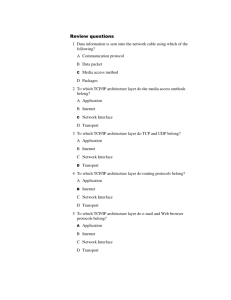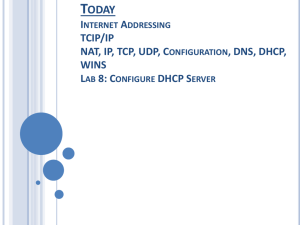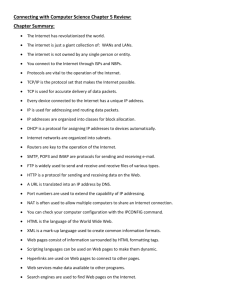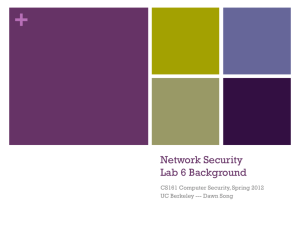Chapter 4 - Wright State University
advertisement
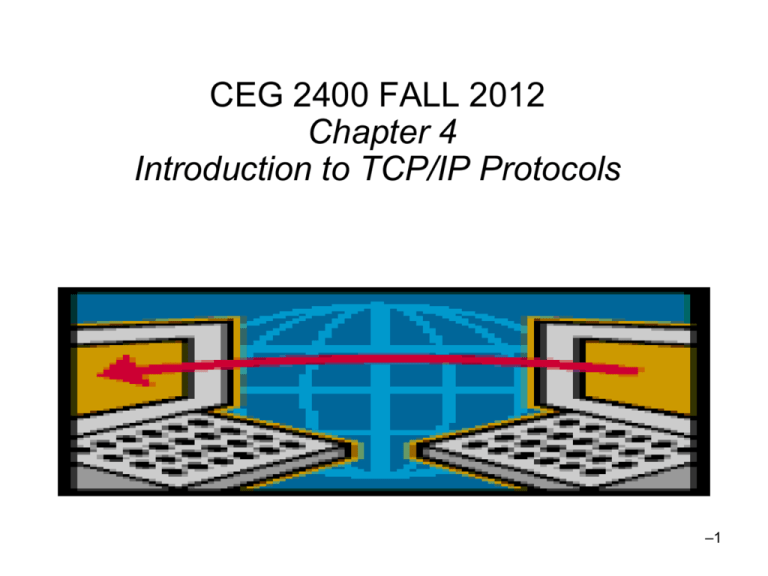
CEG 2400 FALL 2012 Chapter 4 Introduction to TCP/IP Protocols –1 TCP/IP (Transmission Control Protocol/Internet Protocol) • Protocol Suite – Referred to as “IP” or “TCP/IP” • Subprotocols include TCP, IP, UDP, ARP, and others • Developed by US Department of Defense – ARPANET (1960s) 2 Characteristics of TCP/IP • Advantages of TCP/IP – Open nature • Costs nothing – Flexible • Runs on virtually any platform and connects dissimilar operating systems and devices – Routable • Good for large networks • Carries network layer addressing information which makes it routable 3 The TCP/IP Model • Four layers 1. 2. 3. 4. Application layer Transport layer Internet layer Network access layer 4 The TCP/IP model compared with the OSI model 5 The TCP/IP Core Protocols • Operate in Transport or Network layers of OSI model (transport, internet in TCP/IP model) • Provide basic services to protocols in other layers • Most significant protocols in TCP/IP suite – TCP – IP 6 TCP (Transmission Control Protocol) • Transport layer protocol • Provides reliable data delivery services – Connection-oriented subprotocol • Establish connection before transmitting • TCP three-way handshake • Uses sequencing and checksums • Provides flow control • TCP segment format – Encapsulated by IP packet in Network layer • Becomes IP packet’s “data” 7 A TCP segment 8 Fields in a TCP segment 9 TCP segment data 10 Seq(A) +1=Ack(A) Seq(B) +1=Ack(B) Fin flag set Establishing a TCP connection 11 UDP (User Datagram Protocol) • Transport layer protocol • Provides unreliable data delivery services – – – – – Connectionless transport service No assurance packets received in correct sequence No guarantee packets received at all No error checking, sequencing More efficient than TCP • Useful situations – Great volume of data transferred quickly 12 A UDP segment 13 IP (Internet Protocol) • Network layer protocol – How and where data is delivered, including: • Data’s source and destination addresses • Enables TCP/IP to route to other segments • Network layer data formed into packets – IP packet • Data envelope • Contains information for routers to transfer data between different LAN segments 14 IP (cont’d.) • Two versions – IPv4: over 30 years old, still most used – IPv6: Newer version, next version (IPng), released 1998 • Advantages of IPv6 – Provides billions of additional IP addresses – Better security and prioritization provisions 15 An IPv4 packet 16 An IPv6 packet header 17 IGMP (Internet Group Management Protocol) • Operates at Network layer of OSI model • Manages multicasting on networks running IPv4 • Multicasting – Point-to-multipoint transmission method – One node sends data to a group of nodes – Used for Internet teleconferencing or videoconferencing 18 ARP (Address Resolution Protocol) • • • • Network layer protocol Used with IPv4 Obtains MAC (physical) address of host or node Creates database that maps MAC to host’s IP address – ARP table • Table of recognized MAC-to-IP address mappings • Increases efficiency • Contains dynamic and static entries 19 ICMP (Internet Control Message Protocol) • Network layer protocol – Reports on data delivery success/failure • Announces transmission failures to sender – Network congestion – Data fails to reach destination – Data discarded: TTL expired • ICMP cannot correct errors – Provides critical network problem troubleshooting information • ICMPv6 used with IPv6 20 IPv4 Addressing • Networks recognize two addresses – Logical (Network layer) – Physical (MAC, hardware) addresses • IP protocol handles logical addressing • IP format - Unique 32-bit number – Divided into four octets (sets of eight bits) separated by periods – Example: 144.92.43.178 – Network class determined from first octet 21 Commonly used TCP/IP classes 22 IPv4 Addressing (cont’d.) • Class D, Class E rarely used – Class D: value between 224 and 239 • Multicasting – Class E: value between 240 and 254 • Experimental use • Each eight bits (octet) have 256 combinations – Networks use 1 through 254 – 0: reserved as placeholder – 255: reserved for broadcast transmission 23 IPv4 Addressing (cont’d.) • Class A devices – Network ID: first octet (bits 0-7) – Host: second through fourth octets (bits 8-31) • Class B devices – Network ID: first two octet (bits 0-15) – Host: third through fourth octets (bits 16-31) • Class C devices – Network ID: first three octet (bits 0-23) – Host: fourth octets (bits 24-31) 24 IPv4 addresses and their classes 25 IPv4 Addressing (cont’d.) • Loop back address – – – – First octet equals 127 (127.0.0.1) Loopback test Attempting to connect to own machine Powerful troubleshooting tool – use ping command • Windows XP, Vista, Windows 7, etc – ipconfig command to see host IP address • Unix, Linux – ifconfig command 26 IP Binary and Dotted Decimal Notation • Dotted decimal notation – Common way of expressing IP addresses – Decimal number between 0 and 255 represents each octet – Period (dot) separates each decimal (130.108.7.55) • Dotted decimal address has binary equivalent – Convert each octet – Remove decimal points – Ex. 01000100 00100001 00000111 00001110 27 Subnet Mask • • • • Part of IP Configuration 32-bit number identifying a device’s subnet Combines with the device IP address Informs network about segment, network where device attached • Four octets (32 bits, 255.255.255.0) – Expressed in binary or dotted decimal notation • Assigned same way as IP addresses – Manually or automatically (via DHCP) 28 Subnet Mask (cont’d.) Default subnet masks – 29 IPv6 Addressing • Composed of 128 bits • Eight 16-bit fields • Typically represented in hexadecimal numbers – Separated by a colon – Example: FE22:00FF:002D:0000:0000:0000:3012:CCE3 • Abbreviations for multiple fields with zero values – 00FF can be abbreviated FF – 0000 can be abbreviated 0 – Loopback address - ::1 30 IPv6 Addressing (cont’d.) • Three types of addresses – Unicast • Used for transmitting to single device – Multicast • Used for transmitting data to many different devices simultaneously – Anycast • Represents any one interface from a group of interfaces (any router) • Modern devices and operating systems can use both IPv4 and IPv6 31 - Assigning IP Addresses • Government-sponsored organizations dole out IP addresses – IANA, ICANN, RIRs • Companies, individuals – Obtain IP addresses from ISPs • Every network node must have unique IP address – Error message otherwise 32 Assigning IP Addresses (cont’d.) • Static IP address – Manually assigned – To change: modify client workstation TCP/IP properties – Human error causes duplicates • Dynamic IP address – Assigned automatically – Most common method • Dynamic Host Configuration Protocol (DHCP) 33 - DHCP(Dynamic Host Configuration Protocol) • Automatically assigns device a unique IP address • Reasons for implementing – Reduce time and planning for IP address management – Reduce potential for error in assigning IP addresses – Enable users to move workstations and printers – Make IP addressing transparent for mobile users 34 DHCP (cont’d.) • DHCP leasing process – Device borrows (leases) an IP address from DHCP while attached to network • Lease time – Determines how long client gets to keep IP address • DHCP service configuration – Specify leased address range – Configure lease duration • Several steps to negotiate client’s first lease 35 The DHCP leasing process Other TCP/IP items then delivered – 36 DHCP (cont’d.) • Terminating a DHCP Lease – Expire based on period established in server configuration • Circumstances requiring lease termination – DHCP server fails and replaced – Client problems • DHCP services run on several server types – Different NOSes – Installation and configurations vary 37 Private Addresses and Link-Local Addresses • Private addresses – Allow hosts in organization to communicate across internal network – Cannot be routed on public network • Specific IPv4 address ranges reserved for private addresses – 10.0.0.0 through 10.255.255.255 – 172.16.0.0 through 172.16.255.255 – 192.168.0.0 through 192.168.255.255 38 Private and Link-Local Addresses (cont’d.) • Link-local address – Provisional address – Capable of data transfer only on local network segment • Zero configuration (Zeroconf) – Collection of protocols that assign link-local addresses – Part of computer’s operating software • Automatic private IP addressing (APIPA) – Service that provides link-local addressing on Windows clients 39 - Sockets and Ports • Processes (http, ftp, etc) are assigned unique port numbers • Process’s socket – Port number plus host machine’s IP address • Why port numbers – Simplify TCP/IP communications – Ensures data transmitted correctly to correct process • Example – Telnet port number: 23 – IPv4 host address: 10.43.3.87 – Equals Socket address: 10.43.3.87:23 40 Sockets and Ports (cont’d.) • Port number range: 0 to 65535 • Three types – Well Known Ports • Range: 0 to 1023 • Operating system or administrator use – Registered Ports • Range: 1024 to 49151 • Network users, processes with no special privileges – Dynamic and/or Private Ports • Range: 49152 through 65535 • No restrictions 41 Commonly used TCP/IP port numbers 42 - Host Names and DNS (Domain Name System) • TCP/IP addressing – Long, complicated numbers – Good for computers bad for people • People remember words better – Internet authorities established Internet node naming system • Host – Internet device • Host name – Name describing internet device 43 Domain Names • Domain – Group of computers belonging to same organization – Share common part of IP address • Domain name – Identifies domain (wright.edu) – Associated with company, university, government organization • Fully qualified host name or Fully qualified domain name (FQDN) • Ex: wings.wright.edu - Local host name plus domain name 44 Domain Names (cont’d.) • Think of it as a label (character string) separated by dots – Represents level in domain naming hierarchy • Example: www.google.com – Top-level domain (TLD): com – Second-level domain: google – Third-level domain: www • Second-level domain – May contain multiple third-level domains • ICANN established domain naming conventions 45 Domain Names (cont’d.) • ICANN approved over 240 country codes – Examples: .ca => canada, .jp=> japan • Restrictions on Host and Domain names – Any alphanumeric combination up to 253 characters – Include hyphens, underscores, periods in name – No other special characters 46 Some well-known top-level domains (TLD) 47 - Host Files • Computers use Host file to lookup name to IP address – Host matched by one line • Identifies host’s name, IP address and optionally can have an alias which provides a nickname • UNIX-/Linux-based computer – Host file called hosts, located in the /etc directory • Windows computer – Host file called hosts, located in Windows\system32\drivers\etc folder 48 Sample host file 49 DNS (Domain Name System) • DNS refers to: – An organized system of computers with databases making association possible • Hierarchical – Associate domain names with IP addresses • DNS redundancy – Many computers across globe related in hierarchical manner – Root servers • 13 computers (ultimate authorities) • http://www.root-servers.org/ 50 DNS (cont’d.) • Three components to DNS – Resolvers • Any hosts on Internet needing to look up domain name information – Name servers (DNS servers) • Databases of associated names, IP addresses • Provide information to resolvers on request – Namespace • Describes how name servers of the world share DNS information 51 Domain name resolution 52 DNS (cont’d.) • Resource record – Describes one piece of DNS database information – Many different types • Dependent on function Common DNS record types 53 Configuring DNS • Large organizations – Often maintain two name servers • Primary and secondary – Ensures Internet connectivity – Without DNS big problems • DHCP service assigns clients appropriate addresses for DNS • Occasionally may want to manually configure 54 DDNS (Dynamic DNS) • Sometimes hosts IP address changes – Manually changing DNS records unmanageable • Process – Service provider runs program on user’s computer • Notifies service provider when IP address changes – Service provider’s server launches routine to automatically update DNS record • Effective throughout Internet in minutes • Not DNS replacement but enhancement • Larger organizations buy statically assigned IP address 55 - Application Layer Protocols • HTTP – Application layer protocol central to using Web • DHCP – Automatic address assignment • Telnet – Terminal emulation • FTP and TFTP – File transfer (TCP) and trival FTP (UDP) • NTP – Network Time • Ping – Verify Connectivity 56 Telnet • Terminal emulation protocol – Log on to remote hosts using TCP/IP protocol suite – TCP connection established • Keystrokes on user’s machine act like keystrokes on remotely connected machine • Often connects two dissimilar systems • Drawback – Notoriously insecure 57 FTP (File Transfer Protocol) • Send and receive files via TCP/IP • Host running FTP server portion – Accepts commands from host running FTP client • FTP commands – Operating system’s command prompt • No special client software required • Some FTP hosts allow anonymous logons • Secure FTP (SFTP) – More secure version of FTP 58 TFTP (Trivial File Transfer Protocol) • Enables file transfers between computers – Simpler (more trivial) than FTP • TFTP relies on Transport layer UDP – Connectionless – Does not guarantee reliable data delivery • No ID or password required – Security risk • No directory browsing allowed 59 NTP (Network Time Protocol) • Synchronizes network computer clocks • Depends on UDP Transport layer services – Benefits from UDP’s quick, connectionless nature • Time • Cannot wait for error checking • Time synchronization importance – Routing – Time-stamped security methods – Maintaining accuracy, consistency between multiple storage systems 60 PING (Packet Internet Groper) • Provides verification – Things Ping utility give you – TCP/IP installed, bound to NIC, configured correctly, communicating with network – Host responding • Uses ICMP services – Send echo request and echo reply messages • Determine IP address validity • Ping IP address or host name • Ping loopback address: 127.0.0.1 – Determine if workstation’s TCP/IP services running • Operating system determines PING command options, switches, syntax 61 Summary • Protocols define standards for network communication – TCP/IP suite most popular • TCP: connection-oriented subprotocol • UDP: efficient, connectionless service • IP provides information about how and where to deliver data • IPv4 addresses: unique 32-bit numbers • IPv6 addresses: composed of eight 16-bit fields • DHCP assigns addresses automatically • DNS tracks domain names and their addresses • Application layer protocols 62 Commands • • • • • • • • • Arp –a Ipconfig /all Ipconfig /displaydns Ipconfig /flushdns Ping 127.0.0.1 Ping local address Ping router Ping web site Nslookup www.google.com 63 End of Chapter 4 Questions –64



